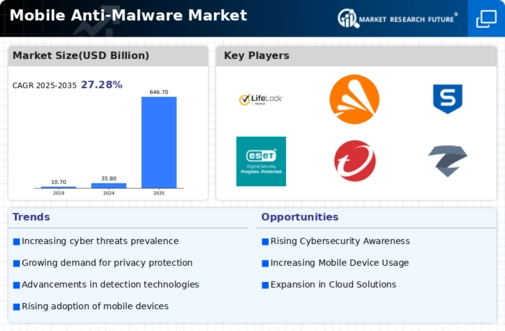Rising Cyber Threats
The increasing prevalence of cyber threats is a primary driver for the Global Mobile Anti-Malware Market Industry. As mobile devices become more integral to daily life, they also attract malicious actors seeking to exploit vulnerabilities. In 2024, the market is projected to reach 35.8 USD Billion, reflecting heightened awareness and demand for protective solutions. The rise in mobile banking, e-commerce, and personal data storage on smartphones has led to a surge in attacks, prompting consumers and enterprises to invest in robust anti-malware solutions. This trend indicates a growing recognition of the need for comprehensive security measures in the mobile ecosystem.
Regulatory Compliance
Regulatory compliance requirements are increasingly influencing the Global Mobile Anti-Malware Market Industry. Governments and regulatory bodies worldwide are implementing stringent data protection laws, compelling organizations to adopt robust security measures for mobile devices. Compliance with regulations such as the General Data Protection Regulation (GDPR) and the California Consumer Privacy Act (CCPA) necessitates the deployment of effective anti-malware solutions to protect sensitive information. As the market evolves, organizations recognize that non-compliance can result in severe penalties and reputational damage. This awareness drives investment in mobile security solutions, contributing to the anticipated growth of the market, projected to reach 646.7 USD Billion by 2035.
Market Growth Projections
The Global Mobile Anti-Malware Market Industry is poised for substantial growth, with projections indicating a market value of 646.7 USD Billion by 2035. This growth trajectory is supported by a compound annual growth rate of 30.1% from 2025 to 2035. The increasing sophistication of cyber threats, coupled with the rising adoption of mobile devices across various sectors, underscores the need for effective anti-malware solutions. As organizations and consumers prioritize mobile security, the market is expected to expand significantly, reflecting the critical role of anti-malware technologies in safeguarding mobile environments.
Technological Advancements
Technological advancements in mobile security solutions significantly contribute to the growth of the Global Mobile Anti-Malware Market Industry. Innovations such as artificial intelligence and machine learning enhance the detection and prevention of malware threats, making security solutions more effective. As these technologies evolve, they provide real-time protection and adaptive responses to emerging threats. The market is expected to experience a compound annual growth rate of 30.1% from 2025 to 2035, driven by the continuous development of sophisticated anti-malware tools. Organizations are increasingly adopting these advanced solutions to safeguard their mobile environments, reflecting a proactive approach to cybersecurity.
Consumer Awareness and Education
Consumer awareness and education regarding mobile security risks are pivotal in shaping the Global Mobile Anti-Malware Market Industry. As individuals become more informed about the potential threats posed by malware, they are more likely to seek protective solutions. Educational initiatives and awareness campaigns by cybersecurity organizations have heightened public understanding of the importance of mobile security. This trend is reflected in the market's growth, with a projected value of 646.7 USD Billion by 2035. Increased consumer vigilance encourages the adoption of anti-malware applications, fostering a culture of security that benefits both individuals and businesses in the mobile landscape.
Increased Mobile Device Penetration
The proliferation of mobile devices globally serves as a catalyst for the Global Mobile Anti-Malware Market Industry. With billions of smartphones and tablets in use, the attack surface for cybercriminals expands, necessitating effective anti-malware solutions. As of 2024, the market is valued at 35.8 USD Billion, underscoring the urgent need for protective measures. The widespread adoption of mobile technology across various sectors, including finance, healthcare, and education, amplifies the risk of malware attacks. Consequently, businesses and consumers alike are prioritizing mobile security, driving demand for comprehensive anti-malware solutions that can address the unique challenges posed by mobile platforms.


























Leave a Comment